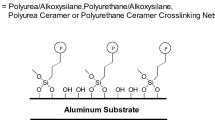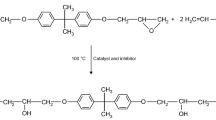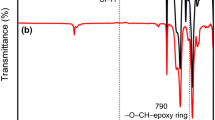Abstract
Cationic ultraviolet (UV) coatings were formulated using a cycloaliphatic diepoxide (3,4-epoxycyclohexyl methyl-3′, 4-′epoxycyclohexane carboxylate) with siloxane modified caprolactone polyols. Both di- and tri-TEOS (tetraethyl orthosilicate) functionalized caprolactone polyols were used to modify the UV coatings. The resulting coatings were cured and evaluated in terms of pencil hardness, MEK double rubs, crosshatch/pull-off adhesion, and reverse impact resistance. Addition of the siloxane-functionalized polyols into the caprolactone polyol/cycloaliphatic diepoxide coating formulations improved pencil hardness, MEK double rubs, and enhanced toughness of the coatings. When the addition of siloxane-functionalized polyols was less than 25 wt%, the resulting coatings had significantly increased adhesion. In addition, modification of the coatings with the siloxane-functionalized polyols also reduced surface tension and improved film formation with reduced levels of surface wetting agent. Without the modification, the coatings exhibited a poor balance of hardness and adhesion.
Similar content being viewed by others
References
Rao, A.V., Kanitkar, D.S., and Parab, A.K.,Prog. Org. Coat., 25, 221 (1995);
Hoyle E. C., Kinstle, F.J.,Radiation Curing of Polymeric Materials, American Chemical Society, Chap. 28 and 29, Washington, D.C., 1989.
Clever, T.R., Dando, N.R., Kolek, P.L., Waterborne, High-Solids, and Power Coatings Symposium, Univ. of Southern Mississippi, Hattiesburg, MS, 440, 1995;
Hoyle, E.C., Kinstle, F.J.,Radiation Curing of Polymeric Materials, American Chemical Society. Chap. 28 and 29, Washington, D.C., 1989.
Wicks, Z.W., Jones, F.N., and Pappas, S.P.,Organic Coatings Science and Technology, John Wiley and Sons, Vol. 2, Chap. 32, New York, 1984;
Price, L.N., “Free Radical and Cationic Photoinitiators in Ultraviolet Light Curable Coatings,”Journal of Coatings Technology,67, No. 849, 27 (1995).
Wicks, Z.W., Jones, F.N., and Pappas, S.P.,Organic Coatings Science and Technology, John Wiley and Sons, Vol. 1, Chap., 11, New York, 1994.
Tokizawa, M., Okada, H., Wakabayashi, N., and Kimura T.,J. Applied Polymer Sci., 50, 627–635 (1993);
Crivello, J.V. and Varlemann, U.,J. Polymer Sci. Part A: Polymer Chem., 33, 2463 (1995);
Monte, D., Galia, M., Cadiz, V., Mantecon, A., and Serra, A.,Makcromol. Chem., 199, 1051 (1995);
Tokizawa, M., Okada, H., Wakabayashi, N., and Kimura, T.,J. Applied Polymer Sci., 50, 627–635 (1993).
Buchwalter, S.L. and Kosbar, L.L.,J. Polymer Sci. Part A: Polymer Chem., 34, 249 (1996).
Koleske, J.V., “Cationic Radiation Curing,”Federation Series on Coatings Technology, Federation of Societies for Coatings Technology, Philadelphia, PA, 1986.
Eaton, R.F., Goldberg, D., Hanrahan, D.B., et al.Surf. Coat. Australia, 29(5), 6 (1992);
Manus, P.J.-M.,Proc. RadTech. Europe 1989, Florence, Italy, 1989;
Koleske, J.V. and Austin, T.M., “New UV-Curable Conformal Coating and An Accelerated Moisture Resistance Test Method,”Journal of Coatings Technology,58, No. 742, 47 (1986).
Cazaux, F., Coqueret, X., Lignot, B., and Loucheux, C., et al., “Epoxidized Polybutadiene: A Novel Prepolymer for Cationically UV-Curable Coatings,”Journal of Coatings Technology,68, No. 838, 27 (1994).
Wu, S., Soucek, M.D., and Simonsick, W.J., “Synthesis of Reactive Diluents for Cationic Cycloaliphatic Epoxide UV Coatings,”Polymer, submitted.
Wu, S. and Soucek, M.D.,Polymer Preprints, 38(1), 492 (1997);
Wu, S. and Soucek, M.D.,Polymer Preprints, 39, 1, 541 (1998).
Wicks, Z.W., Jones, F.N., and Pappas, S.P.,Organic Coatings Science and Technology, John Wiley and Sons, Vol. 2, Chap., 26, New York, 1994.
Chen, M.J., Osterholtz, F.D., Pohl, E.R., Ramdatt, P.E., Chaves, A., and Bennett, V., “Silanes in High-Solids and Waterborne Coatings,”Journal of Coatings Technology,69, No. 870, 43 (1997);
Adamson, A.W. and Gast, A.P.,Physical Chemistry of Surfaces, John Wiley and Sons, Chap. 7 and 8, New York, 1997.
Author information
Authors and Affiliations
Additional information
Dept. of Polymers & Coatings, Fargo, ND 58105.
Rights and permissions
About this article
Cite this article
Wu, S., Soucek, M.D. Effect of siloxane functionalized caprolactone polyols on photocurable epoxy coatings. Journal of Coatings Technology 70, 53–62 (1998). https://doi.org/10.1007/BF02700543
Issue Date:
DOI: https://doi.org/10.1007/BF02700543




